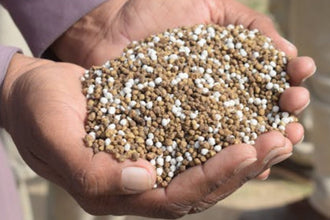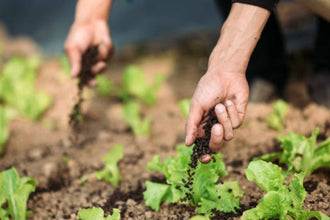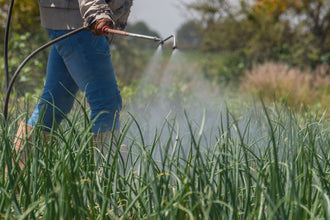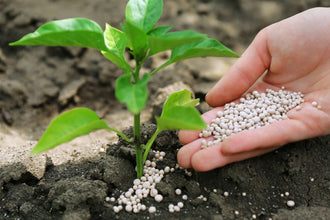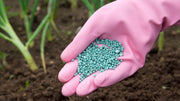
Starter fertilizer helps young plants get the nutrients they need when they're just starting out. You know how babies need special formula or breast milk? Well, plants are pretty similar. Seeds and seedlings are basically plant babies, and they need extra care during those first few weeks of life.
Most gardeners plant their seeds or transplants and hope for the best. But here's what many people don't realize: those tiny plants are struggling to survive right from day one. They're trying to grow roots, make leaves, and figure out how to live in your garden soil. Without the right nutrition early on, they might make it, but they won't thrive.
Think about it this way. A seed has some stored energy, kind of like a packed lunch. But that lunch doesn't last very long. Once it's gone, the plant has to find food in the soil around it. If there's nothing good nearby, the plant stays small and weak. Professional farmers figured this out years ago. They almost never plant anything without giving it some starter nutrition first.
What Happens When Plants First Start Growing
Plants go through different stages as they grow, and each stage has different needs. When a seed first sprouts, it's living off the energy packed inside the seed coat. But once that little plant breaks through the soil surface, everything changes fast.
The plant suddenly needs to start making its own food through photosynthesis. But it can't do that very well with tiny leaves and almost no root system. This is where starter fertilizer comes in handy. It gives the plant exactly what it needs to build a strong foundation.
Young plants need three main things to get going. They need phosphorus to grow good roots. Without decent roots, they can't get water or nutrients from the soil later on. They need nitrogen to make green leaves. Those leaves are like solar panels that capture sunlight and turn it into plant food. And they need potassium to stay healthy and fight off diseases.
Different seeds have different amounts of stored energy. Big seeds like beans or sunflowers have more packed lunch than tiny seeds like lettuce or carrots. But even the big seeds run out of steam pretty quickly. That's why starter fertilizer works so well for all types of plants.
Weather plays a big role too. Cold soil makes it harder for plants to absorb nutrients. Their roots move slower and can't pick up food as easily. Spring planting often happens when the soil is still pretty cold, which makes starter nutrition even more important.
Choosing the Right Starter Fertilizer
Not all plants need the same type of starter fertilizer. Vegetables usually want more phosphorus because they need to grow strong roots quickly. Flowers need balanced nutrition to support both roots and early blooms. Grass seed needs nitrogen to germinate fast and turn green.
What Different Plants Need
Vegetables like tomatoes, peppers, and cucumbers really benefit from phosphorus-heavy starter fertilizer. These plants will eventually carry heavy loads of fruit, so they need solid root systems from the start. Cool weather vegetables like lettuce and spinach also like phosphorus, but they don't need as much overall nutrition.
Flower gardens work best with balanced starter nutrition. Annual flowers need to establish quickly and start blooming right away. Perennial flowers focus more on building roots during their first year. Both types do better with proper starter feeding.
Grass seed has its own special needs. It needs nitrogen to germinate quickly and turn green fast. But too much nitrogen can actually burn the tender new grass. The best grass starter fertilizers give gentle nutrition that won't hurt baby grass plants.
Organic vs Synthetic Options
Organic starter fertilizer takes longer to work but lasts longer too. These products feed the helpful bacteria and fungi in your soil, which then help your plants absorb nutrients better. Organic options also make your soil better over time. They're less likely to burn sensitive seedlings.
Synthetic starter fertilizers work right away. Plants can use these nutrients immediately without waiting for soil microbes to break them down. This quick action helps when your soil is cold or when plants need to establish fast. But synthetic products don't do anything to improve your soil health long term.
Chicken manure based fertilizers give you the best of both worlds. They provide some quick nutrition while also feeding the good microbes in your soil. A 4-2.5-2 NPK ratio from quality chicken manure products supports root growth and early development without overwhelming young plants.
When and How to Apply Starter Fertilizer
Timing makes a huge difference with starter fertilizer. You want to apply it right before you plant for the best results. This puts the nutrients exactly where seeds or transplants can find them immediately. If you apply it too late, you've missed the window when plants need it most.
Getting the Timing Right
The best time to add starter fertilizer is during soil prep. Mix it into your planting area instead of just sprinkling it on top. This gets the nutrients down where the roots will be growing. Broadcasting fertilizer on the surface might not get it to the right spot.
Weather matters for timing too. Don't apply starter fertilizer right before a heavy rain that might wash it away. A light watering after application helps move nutrients into the root zone without losing them to runoff.
Here's what works best for different situations:
• Broadcasting: Works great for large areas like new lawns or big vegetable gardens. Spread the fertilizer evenly, then work it into the top few inches of soil.
• Banding: Places fertilizer in rows where you'll plant. This concentrated approach puts nutrients exactly where developing roots will find them. You can use less fertilizer this way since it's more targeted.
• Individual application: Best for transplants or plants that are spaced far apart. Put a small amount around each plant's root zone and mix it into the soil.
• Side-dressing: Apply fertilizer alongside existing plants that seem to be struggling. Keep it a few inches away from plant stems and water lightly afterward.
How Much to Use
Getting the amount right prevents problems. Too much starter fertilizer can burn seedlings or cause too much leaf growth and poor root development. It's better to use a little less than to overdo it.
Soil testing helps you figure out what your soil already has. If your soil is already high in phosphorus, you might not need a phosphorus-rich starter fertilizer. If your soil is low in organic matter, organic starter fertilizers will help more.
Mixing starter fertilizer with compost or other organic matter makes it work better. The organic matter holds nutrients in the root zone longer and provides additional slow-release nutrition as plants grow. A 50-50 mix of starter fertilizer and compost works well for most situations.

Common Mistakes People Make
Even experienced gardeners make mistakes with starter fertilizer. Here are the most common ones and how to avoid them.
Using too much is probably the biggest mistake. People think if a little is good, more must be better. But over-application burns seedlings and can actually slow down growth. Always follow the directions on the package.
Wrong nutrient ratios cause problems too. High nitrogen starter fertilizers might make plants grow lots of leaves but poor roots. High potassium formulations can interfere with how plants absorb other nutrients. Balanced formulations work best for most situations.
Poor placement wastes your money and doesn't help your plants. If you just sprinkle fertilizer on top of established soil, it often stays too far away from developing roots. You need to work it into the planting area where plants can actually use it.
Not thinking about soil conditions leads to disappointing results. Cold, wet soil slows down nutrient release from organic fertilizers. Hot, dry conditions can concentrate synthetic fertilizers to levels that damage plants. Consider what your soil conditions are like when choosing and applying starter fertilizer.
Making Starter Fertilizer Work Better
Getting good results with starter fertilizer isn't just about buying the right product. How you measure, mix, and apply it makes a big difference in how well it works.
Accurate measuring prevents over-application and plant damage. Use measuring cups or a scale instead of eyeballing it. Different fertilizer products have different weights, so a cup of one brand might contain more actual fertilizer than a cup of another brand. Weighing gives you more consistent results.
Water management affects how well plants can use starter nutrition. Consistent moisture helps nutrients dissolve and move to where roots can find them. But waterlogged soil prevents good root development no matter how much fertilizer you use. Make sure your soil drains well and you're watering appropriately.
Testing your soil before applying starter fertilizer tells you what you're working with. You might discover your soil already has plenty of certain nutrients. Or you might find out your soil needs extra help in specific areas. Testing prevents unnecessary applications and saves you money.
Why Fancy Chicken Fertilizer Works as an Ideal Starter Fertilizer
Organic pelletized chicken manure offers something synthetic starter fertilizers can't match: both immediate nutrition and long-term soil building. Fancy Chicken's 4-2.5-2 NPK formula provides exactly what young plants need during those critical first weeks while creating healthier soil for future seasons.
Perfect Nutrient Balance for Young Plants
The 4-2.5-2 ratio in Fancy Chicken fertilizer gives seedlings and transplants balanced nutrition without overwhelming them. Young plants get enough nitrogen for healthy green growth, adequate phosphorus for strong root development, and sufficient potassium for disease resistance. This gentle approach prevents the burning that sometimes happens with high-concentration synthetic starters.
Chicken manure breaks down gradually in the soil, releasing nutrients over several weeks instead of all at once. This extended feeding keeps plants nourished throughout their establishment period. You won't see that quick green-up followed by nutrient crash that synthetic products sometimes cause.
The organic matter in pelletized chicken manure also improves soil structure around developing roots. Better soil structure means better water retention and improved air circulation. These conditions help young root systems spread and establish more effectively.
Building Stronger Soil While Feeding Plants
Fancy Chicken fertilizer does more than just feed individual plants. The organic matter feeds beneficial soil microbes that create a healthier growing environment. These microbes form partnerships with plant roots, helping them absorb nutrients more efficiently throughout the growing season.
Here's how Fancy Chicken improves your soil while working as starter fertilizer:
-
Increases microbial activity that breaks down organic matter and makes nutrients more available
-
Improves soil structure by adding organic matter that holds moisture and creates air pockets
-
Builds long-term fertility instead of just providing a quick nutrient fix
-
Reduces soil compaction around root zones, making it easier for plants to establish
-
Enhances water retention so plants stay hydrated during dry periods
Application Tips for Best Results
Apply Fancy Chicken fertilizer about two weeks before planting to give it time to start breaking down in the soil. Work it into the top 4-6 inches of your planting area rather than just spreading it on the surface. This placement puts nutrients exactly where developing roots will find them.
For direct seeding, use about 2-3 pounds per 100 square feet mixed into the planting area. For transplants, work about 1/4 cup into each planting hole and mix it with the surrounding soil. Water lightly after planting to help activate the organic nutrients.
The gradual release means you can apply Fancy Chicken earlier than synthetic starters without worrying about nutrient loss. Spring applications work well even in cold soil because the organic matter slowly becomes available as soil temperatures warm up.
Cost-Effective Long-Term Benefits
While organic starter fertilizer like Fancy Chicken costs more upfront than synthetic options, it provides value that extends well beyond the initial growing period. The soil improvement benefits last for months, reducing the need for additional fertilizer applications during the season.
Plants started with quality organic fertilizer typically need less intervention throughout their growing period. They develop stronger disease resistance, better drought tolerance, and more productive root systems. These benefits translate into less work and better harvests for gardeners.
Start Growing Success Today
Your plants deserve the best possible beginning, and that starts with the right nutrition at the right time. Starter fertilizer sets the foundation for everything that follows in your garden. Strong, well-established plants produce better harvests, resist problems more effectively, and require less maintenance throughout the season.
The difference between plants that struggle and plants that thrive often comes down to those first few critical weeks after planting. Give your garden the organic nutrition it needs with Fancy Chicken fertilizer to build healthy soil while feeding hungry seedlings. Your plants will reward you with stronger growth, better yields, and the satisfaction of knowing you're building garden soil that gets better every year with Fancy Chicken's natural approach.




